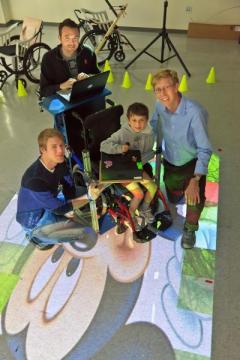David Reinkensmeyer Gives Lecture at Biomedical Engineering Society Annual Meeting
Reinkensmeyer gives NIH National Institute of Biomedical Imaging and Bioengineering Lecture
 Professor David J. Reinkensmeyer, Ph.D., Department of Mechanical and Aerospace Engineering with a split appointment in the Department of Anatomy and Neurobiology in the School of Medicine, and a joint appointment in the Department of Biomedical Engineering, was selected to give the National Institutes of Health (NIH) National Institute of Biomedical Imaging and Bioengineering Lecture on Friday, October 14, at the 2011 Biomedical Engineering Society (BMES) Annual Meeting in Hartford, Conn.
Professor David J. Reinkensmeyer, Ph.D., Department of Mechanical and Aerospace Engineering with a split appointment in the Department of Anatomy and Neurobiology in the School of Medicine, and a joint appointment in the Department of Biomedical Engineering, was selected to give the National Institutes of Health (NIH) National Institute of Biomedical Imaging and Bioengineering Lecture on Friday, October 14, at the 2011 Biomedical Engineering Society (BMES) Annual Meeting in Hartford, Conn.
Advances in robotics are assisting people with sensory motor impairment in achieving greater mobility. Exoskeletons help those with paralysis to walk and use their hands and robotic training devices allow movement training to be delivered in more intense, motivating and quantifiable ways. However, even with these advances in rehabilitation technology, individuals with mobility impairment still too often experience insufficient recovery.
Reinkensmeyer’s lecture, entitled “Robotics and Sensory Motor Restoration,” described efforts of rehabilitation, robotics and neural engineers to develop technologies to assist the injured motor system in reorganizing in a way that best promotes functional recovery. A central theme in the lecture is that technologies providing an optimal level of challenge to the patient produce better therapeutic outcomes. A key question is whether optimal recovery requires more sophisticated assistive technologies, such as multi-joint exoskeletons, that can assist in more naturalistic movement.
Treatments that combine regenerative or plasticity enhancing therapies with intensive motor learning experiences will facilitate neuro-recovery beyond what is currently possible; and these treatments will require a new science of combination therapies to be developed.
Reinkensmeyer received a B.S. in electrical engineering from the Massachusetts Institute of Technology in 1988 and M.S. and Ph.D. degrees in electrical engineering from the University of California, Berkeley in 1991 and 1993, respectively. His postdoctoral studies were at the Rehabilitation Institute of Chicago and Northwestern University Medical School from 1994 to 1997, building one of the first robotic devices for rehabilitation therapy after stroke. He became an assistant professor at The Henry Samueli School of Engineering in 1997, establishing a research program that develops robotic and sensor-based systems for movement training and assessment following neurologic injuries and disease. He is the director of the Biorobotics Laboratory at UC Irvine and is the lead researcher for iMove, a collaborative effort in the California Institute for Telecommunications and Information Technology (Calit2) and the Sue and Bill Gross Stem Cell Research Center focused on using technology to help restore human mobility.
Dr. Reinkensmeyer’s research group seeks to understand how to improve sensory motor recovery following neurologic injury and disease. Since motor learning and neuroplasticity occur in response to the physical effects of motion, his group manipulates the physics of motor tasks with robots to try to enhance motor learning, developing and drawing on computational models of neuromotor learning and plasticity to provide a rational framework for device development. Increasingly his group is interested in combining technologies for movement training with regenerative therapies, including stem cell therapies. He is also seeking to develop sensor-based technologies for movement evaluation that improve insight into regenerative clinical trials by enabling continuous, high-resolution assessment of neuro-muscular control.
